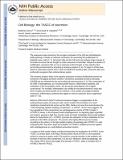The TASCC of Secretion
Author(s)
Zoncu, Roberto; Sabatini, David
DownloadSabatini_the TASCC.pdf (206.7Kb)
OPEN_ACCESS_POLICY
Open Access Policy
Creative Commons Attribution-Noncommercial-Share Alike
Terms of use
Metadata
Show full item recordAbstract
The oncogene-induced activation of signaling pathways involving the tumor suppressor proteins p53 and retinoblastoma is likely an important mechanism for preventing the proliferation of potential cancer cells (1, 2). This activation causes cells to exit the cell division cycle and enter a senescent state, which is characterized by major changes in chromatin structure that are thought to render senescence irreversible. Despite the absence of proliferation, senescent cells are not as quiescent as first thought, as they signal to their surrounding environment by activating a protein secretion program (3, 4). On page 966 of this issue, Narita et al. (5) show that to enable this secretory state, a senescent cell profoundly reorganizes its endomembrane system.
Description
Author Manuscript 2012 July 05
Date issued
2011-05Department
Massachusetts Institute of Technology. Department of Biology; Whitehead Institute for Biomedical Research; Koch Institute for Integrative Cancer Research at MITJournal
Science
Publisher
American Association for the Advancement of Science (AAAS)
Citation
Zoncu, R., and D. M. Sabatini. “The TASCC of Secretion.” Science 332, no. 6032 (May 19, 2011): 923-925.
Version: Author's final manuscript
ISSN
0036-8075
1095-9203